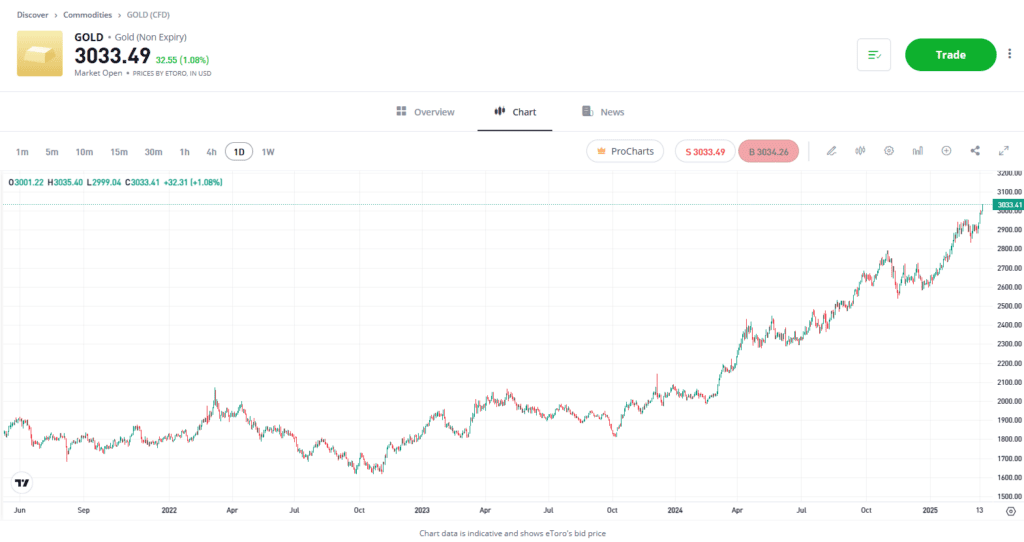Investing in gold in Australia may seem to be a fairly straightforward process, but it’s important to consider the risks and to research the long-term strategies involved. You can invest in gold via physical assets, exchange-traded funds and mining companies.
Growing your portfolio with gold does not have to involve standing in a stream panning for precious metals. On the contrary, investing in gold can be as simple as trading shares.
Many retail investors prefer the perceived safety of gold during economic or political instability, and they may even diversify into gold to balance out their portfolio — hoping that the historical trend of the price of gold rising whenever the market takes a tumble continues.
While past performance should never be used as an indicator of future success, people’s preference for investing in gold continues to this day. This guide will explore everything you need to know about gold investing in Australia, and share helpful information about the state of gold today and beyond.
What should you know about the gold industry?
Whether or not you believe gold is a good fit for your portfolio, there’s no denying its importance to the Australian and global markets. Its relative rarity means that it continues to be an attractive prospect for everyone from the average consumer right up to multinational mining corporations.
Estimates say that about 200,000 tonnes of gold have been mined around the world, as of 2025, with about two-thirds of this coming in the last 70 years or so. It is estimated that another 2,000-3,000 tonnes are mined globally each year.
Australia has been, and remains, a prime location for gold supplies. In fiscal year 2024, Australia produced 289 metric tonnes of gold, the third highest amount in the world after China (380 metric tonnes) and the Russian Federation (310 metric tonnes). About 60% of our country’s gold reserves are in Western Australia.

How have gold stocks performed historically?
While the history of gold is intriguing, investors generally only care about one thing: how it is performing in the markets.
First, it is important to define how people invest in gold. This is generally broken down into three criteria: physical assets, exchange-traded funds (ETFs) and mining companies.
Physical assets
This includes everything from gold bullion bars to jewellery, coins and more. While some people like to physically own the gold they are investing in, it is not the most straightforward solution, or the most lucrative in many circumstances.
Exchange-traded funds (ETFs)
Considered by many to be more stable than exploration mining companies and even blue-chip miners, ETFs that focus on gold allow you to get exposure to the commodity without having to physically own and store it yourself.
Mining companies
Depending on your risk appetite, investing in gold mining companies may be preferable than investing in ETFs.
While the share price of these companies tends to move in tandem with the price of gold, be aware that there may be an “amplification” factor to any market changes — meaning bigger jumps when the price of gold is rising, but also bigger drops when it falls.
Tip: Ensure that you do your due diligence on the different types of gold companies before adding them to your portfolio.
Historically, gold stocks have remained fairly steady over the decades before the price of gold began to increase year-on-year from the mid-2000s. In March 2025, gold hit an all-time high of almost US$3,040 per ounce, and analysts predict that the stock will reach $7,000 by the end of 2030.
What should you consider when investing in gold?
When looking to invest in gold, you should consider the type of strategy you wish to build. For example, if you’re interested in hedging, you should ask yourself how gold stocks can help to diversify your portfolio. Here are the main things to consider when thinking about investing in gold.

Do you want to hedge?
If you want to hedge, you should understand that gold has historically been a popular investment when either the US dollar is declining or inflation is on the rise.
When investors’ money starts to lose value, they turn to commodities where the assets, such as gold, have traditionally retained their value.
Do you want to “park” your money in a safe haven?
If so, gold could be a potential option. When political and economic uncertainty are disrupting the markets, many investors see gold as a safe haven asset.
Do you want to diversify?
Diversification is a key strategy among most investors, and gold allows you to spread your risk across hard assets without having to worry about rising inflation or a dropping US dollar to protect your investment.
Whether you are keen to balance your investment risks with a commodity such as gold or you prefer the excitement of investing purely in shares, make sure that you do your research before deciding whether it is the right addition to your portfolio. Don’t forget to explore the ins and outs of commodity trading so that you can invest with confidence.
Some popular gold stocks include:
How do you want to own gold?
While you can invest in gold on the share market through gold mining companies and gold ETFs, for example, you may be interested in owning gold through investing in gold bullion, jewellery, coins and more.

Can investing in gold offer dividends?
Investing in gold stocks may be attractive if you wish to earn dividends on your investment. For example, even if the price of gold is dropping, some gold mining companies can perform very well.
In fact, by investing in some of the best gold stocks, you could see a higher return on investment through dividends than you would by owning physical gold.
Tip: Blue chip stocks are a popular choice for dividend investors, as they typically pay dividends and are a stable, established option.
Gold market: a case study
The graph below clearly shows how the price of gold is currently in an established upward trend. From trading below $17,000 per oz in November 2023, it has rallied to break through the psychologically important $30,000 per oz price barrier.

Past performance is not an indication of future results.
Source: eToro
Every price trend eventually stalls and anyone considering buying gold should carry out appropriate research. However, identifying trends and timing your entry into positions correctly is one of the secrets to successful investing.
Tip: While gold may be one of the best-known commodities, you can also invest in other commodity sectors, including metals, energy and agriculture.
Final thoughts
The timeless allure of gold can become more attractive during times of uncertainty. The old adage that gold increases in price when everything else falls might not be borne out by historical data, but the way that the metal offers diversification makes it worthy of consideration in any portfolio.
Build your investing knowledge with the eToro Academy.
FAQs
- Is gold a good investment option for me?
-
This will depend on your overall investment strategy and the type of assets you wish to invest in. For some, gold is a good investment option because it has continued to maintain its value over the long term despite its volatility.
- When should I invest in gold?
-
Regardless of the asset type, the best time to invest in something is when it is inexpensive and there is significant upside potential. This means that when its price rises, you will have entered at a potentially beneficial time.
- How much gold should I have in my portfolio?
-
Much like any other asset, deciding how much gold to include in your investment portfolio is a personal choice. Be sure to consider your risk tolerance and your personal financial goals before investing.
This information is for educational purposes only and should not be taken as investment advice, personal recommendation, or an offer of, or solicitation to, buy or sell any financial instruments.
This material has been prepared without regard to any particular investment objectives or financial situation and has not been prepared in accordance with the legal and regulatory requirements to promote independent research. Not all of the financial instruments and services referred to are offered by eToro and any references to past performance of a financial instrument, index, or a packaged investment product are not, and should not be taken as, a reliable indicator of future results.
eToro makes no representation and assumes no liability as to the accuracy or completeness of the content of this guide. Make sure you understand the risks involved in trading before committing any capital. Never risk more than you are prepared to lose.


